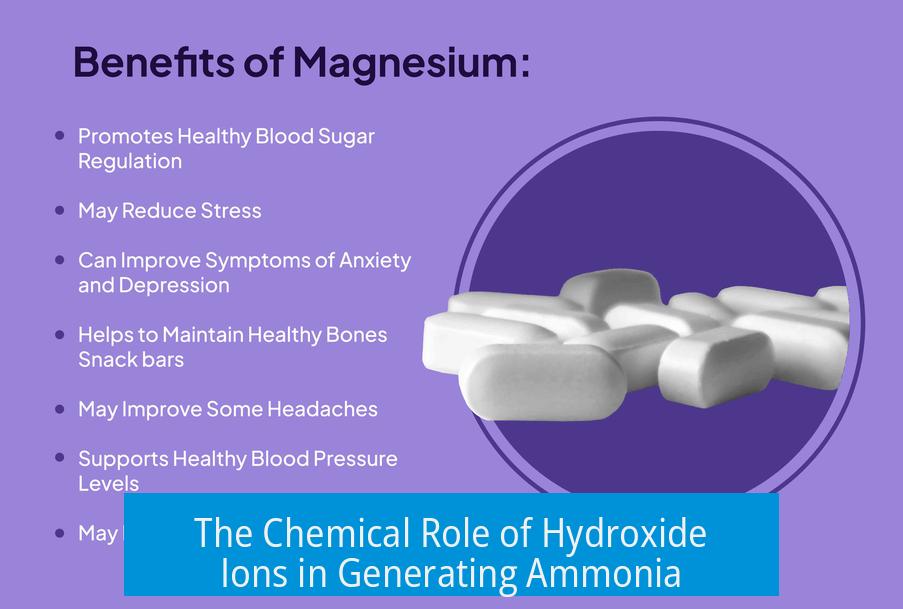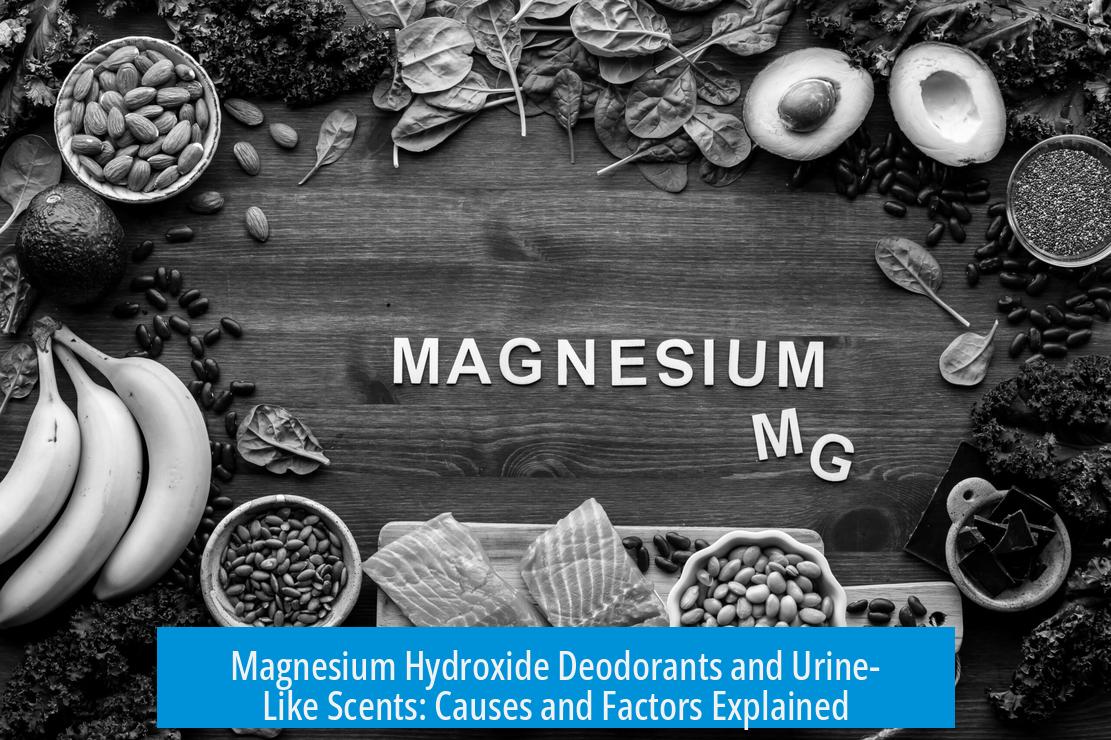Why Do Some Magnesium Hydroxide Deodorants Cause a Urine-Like Scent?
 Some magnesium hydroxide deodorants cause a urine-like scent because magnesium hydroxide raises the skin’s pH, promoting odor-causing bacteria that produce ammonia-like compounds. This effect varies by individual body chemistry and the deodorant’s ingredients. Over time, as the deodorant’s antimicrobial strength decreases, microbes metabolize sweat and deodorant chemicals, creating new odors including those resembling urine.
Some magnesium hydroxide deodorants cause a urine-like scent because magnesium hydroxide raises the skin’s pH, promoting odor-causing bacteria that produce ammonia-like compounds. This effect varies by individual body chemistry and the deodorant’s ingredients. Over time, as the deodorant’s antimicrobial strength decreases, microbes metabolize sweat and deodorant chemicals, creating new odors including those resembling urine.
Magnesium Hydroxide’s Effect on Skin pH and Microbial Growth
Magnesium hydroxide, often used in deodorants as a natural alternative to aluminum compounds, works by raising the skin’s pH. Human skin typically has a mildly acidic pH around 4.5 to 5.5. Magnesium hydroxide increases this pH somewhat, which inhibits the growth of many bacteria.
However, not all bacteria respond the same. A specific family of odor-causing bacteria prefers less competition and thrives in the higher pH environment created by magnesium hydroxide. These bacteria multiply more freely due to reduced competition from acid-loving microbes. As a result, the overall microbial population on the skin changes, producing different scent profiles. These new scents can sometimes smell like urine.
Microbial Metabolism of Deodorant Ingredients Produces Ammonia-Like Odors
Many magnesium hydroxide deodorants contain additional active ingredients. For instance, Piroctone Olamine, an amine salt used as an antifungal and antimicrobial, is common.
When skin microbes metabolize amine compounds like Piroctone Olamine, they produce byproducts such as waxy amines and ammonia-like molecules. Ammonia, a compound with a distinctive sharp, urine-like odor, can be emanated from this process. The production of ammonia-like compounds by bacterial metabolism behind the scenes is a key factor in the distinctive odor change.
The Declining Efficacy of Deodorants Contributes to Odor Changes
Most deodorants lose some antimicrobial activity throughout the day. Unlike aluminum-based antiperspirants, which block sweat glands and suppress microbial growth strongly, magnesium hydroxide deodorants may gradually lose their effectiveness.
As the deodorant’s activity diminishes, microbes regain the ability to proliferate. These microbes begin breaking down the deodorant’s residual chemical components combined with sweat. This metabolic activity produces new chemical mixtures, many of which can have strong, unusual odors including ones that resemble urine.
This interaction explains why the urine-like smell might only appear after several hours of wear or later in the day.
The Chemical Role of Hydroxide Ions in Generating Ammonia

The hydroxide ion (OH-) present in magnesium hydroxide can chemically react with nitrogen-containing substances in sweat or on the skin.
Such reactions can convert organic nitrogen compounds into ammonia or related nitrogenous substances. Ammonia has a distinct, sharp smell closely associated with urine. This chemical conversion adds another source of urine-like odor beyond microbial metabolism.
Individual Variations in Body Chemistry Affect Odor Profiles
Body chemistry varies significantly from person to person.
Factors such as genetics, diet, sweat composition, and the skin microbiome influence how a deodorant smells on an individual. Some people may never notice a urine-like scent from magnesium hydroxide deodorants. Others may experience it prominently due to how their skin chemistry interacts specifically with the magnesium and other deodorant ingredients.
Thus, magnesium hydroxide is not inherently malodorous but becomes so in conjunction with particular individual biological factors.
Microbial Colonies and Comparison to Odors in Synthetic Clothing
Scientific studies show microbial colonies can cause persistent odors in situations involving synthetic clothing. Certain microbes thrive on synthetic fibers and break down sweat or detergents, producing strong odors resistant to removal.
The analogy extends to how magnesium hydroxide changes the skin environment. By altering skin pH and microbial balance, it encourages odor-causing microbes to colonize, shifting the scent profile dramatically and sometimes producing sharp urine-like odors.
Summary Table: Causes of Urine-Like Scent from Magnesium Hydroxide Deodorants
| Factor | Description | Relation to Urine-Like Odor |
|---|---|---|
| Raised Skin pH | Magnesium hydroxide increases skin pH, inhibiting some bacteria but promoting others | Favors growth of bacteria producing ammonia-like smells |
| Deodorant Ingredients (e.g., Piroctone Olamine) | Molecules metabolized by bacteria create ammonia-related compounds | Generates sharp, urine-like odors during microbial breakdown |
| Deodorant Efficacy Over Time | Loss of antimicrobial action allows microbial growth metabolizing sweat and chemicals | Creates new odor profiles, including urine-like smells |
| Chemical Hydroxide Reactions | Hydroxide ions produce ammonia from sweat nitrogen compounds | Direct chemical generation of ammonia odor |
| Individual Body Chemistry | Variations in skin composition influence odor formation | Determines if urine-like scent manifests for a person |
| Microbial Analogies (Synthetic Clothing) | Microbes can create resistant odors in synthetic fabric environments | Mirror effect likely on skin with altered microbiome from magnesium |
Key Takeaways
- Magnesium hydroxide raises skin pH, changing bacterial populations on skin.
- Certain odor-causing bacteria flourish and produce ammonia-like smells.
- Ingredients like Piroctone Olamine can be metabolized into urine-like odors.
- Deodorant effectiveness declines during the day, allowing microbial odor formation.
- Hydroxide ions chemically convert sweat compounds into ammonia.
- Individual skin chemistry largely determines if urine-like scent occurs.
Why do some magnesium hydroxide deodorants cause a urine-like smell?
Magnesium hydroxide raises skin pH, stopping many bacteria but allowing certain odor-causing ones to flourish. These bacteria create new smells, sometimes similar to urine.
Can deodorant ingredients like Piroctone Olamine produce ammonia-like odors?
Yes. When microbes break down Piroctone Olamine, they release waxy-amine molecules that smell like ammonia, contributing to a urine-like scent.
Does sweat interacting with deodorant chemicals affect odor?
When a magnesium hydroxide deodorant wears off, microbes consume leftover chemicals and sweat, producing unusual odors like urine.
How does the hydroxide ion influence odor formation?
Hydroxide may convert sweat compounds into ammonia or related substances, which smell similar to urine.
Why do some people notice this urine-like scent while others don’t?
Individual skin chemistry varies. Magnesium reacts differently with each person’s skin, so some may develop urine-like odors while others do not.





Leave a Comment